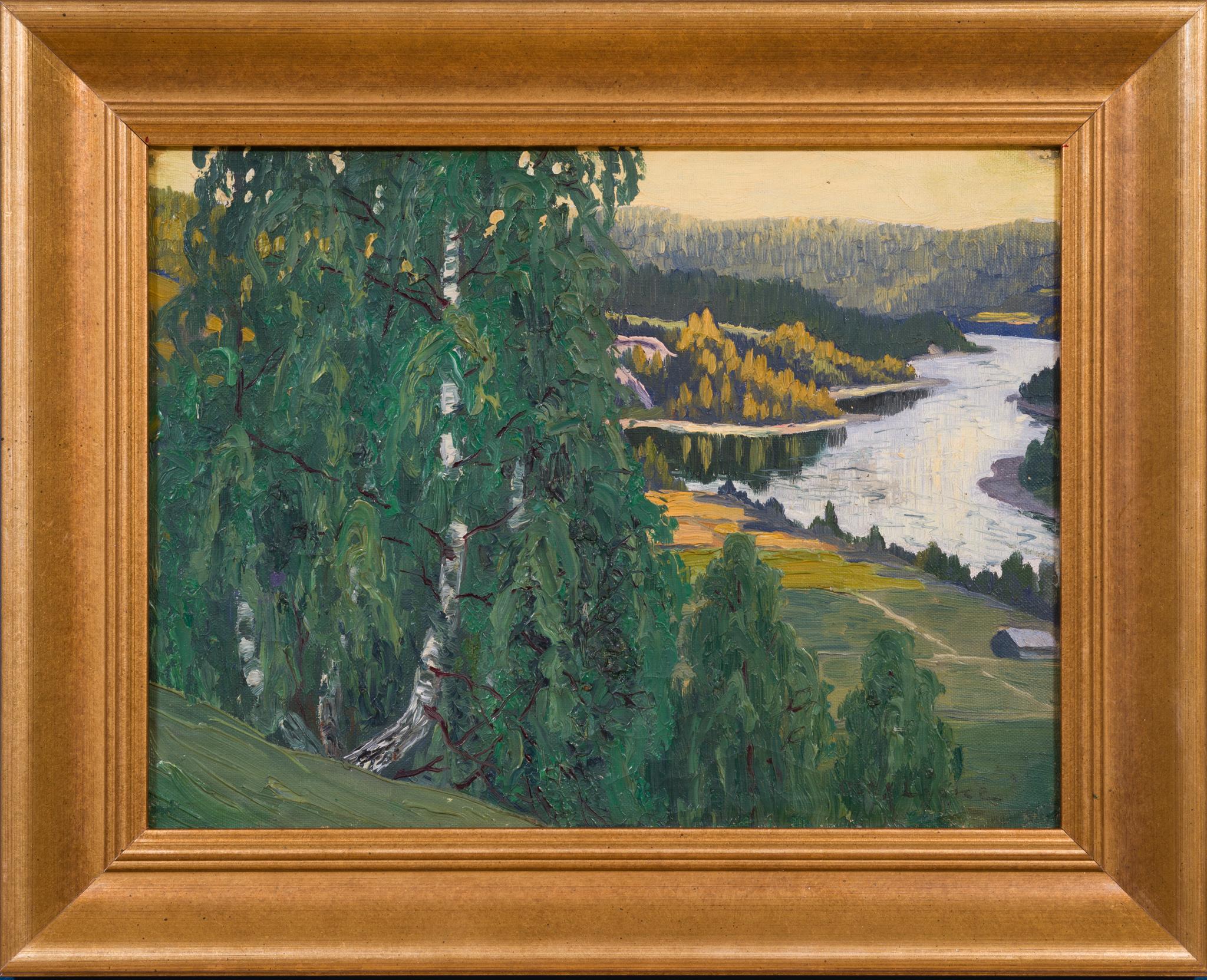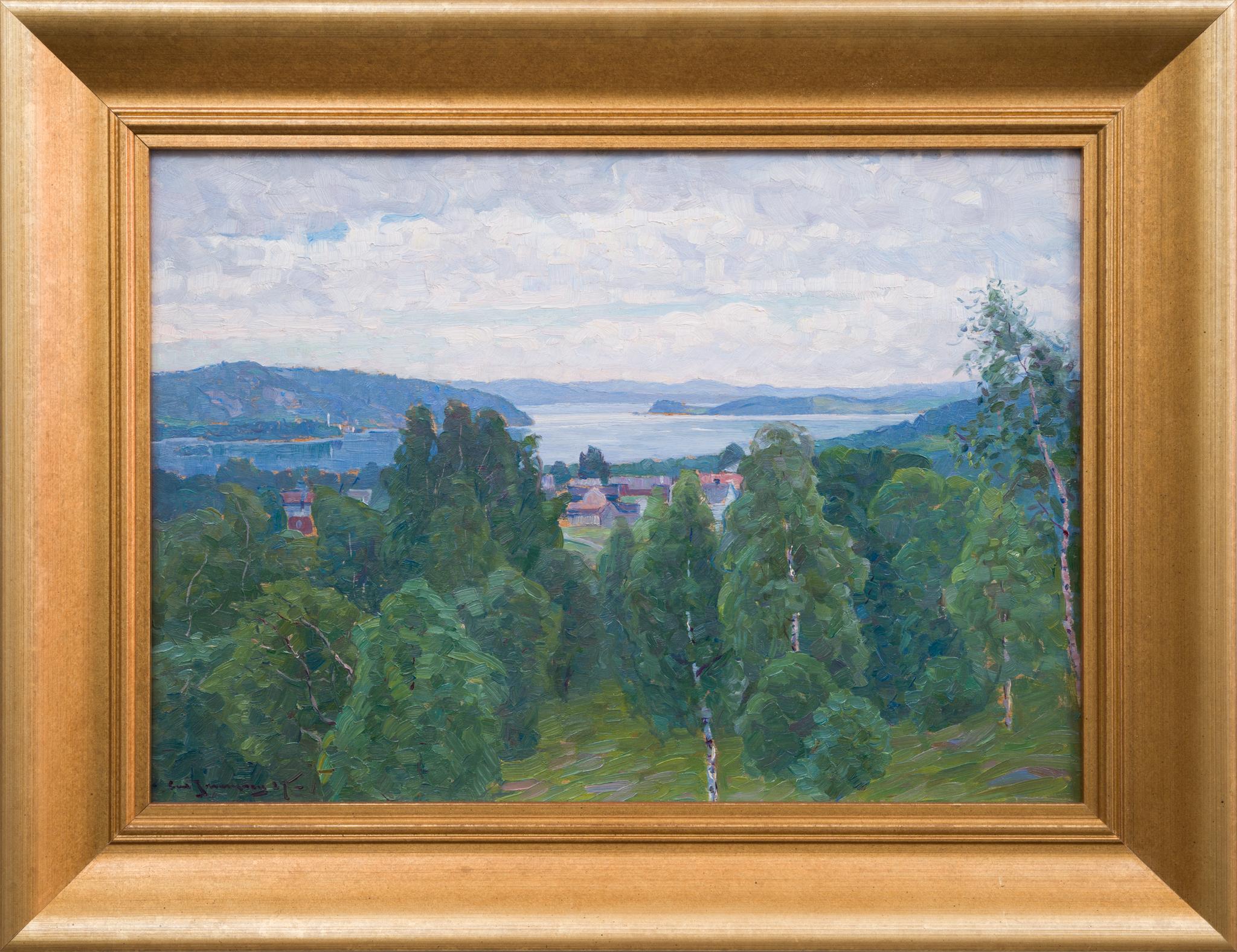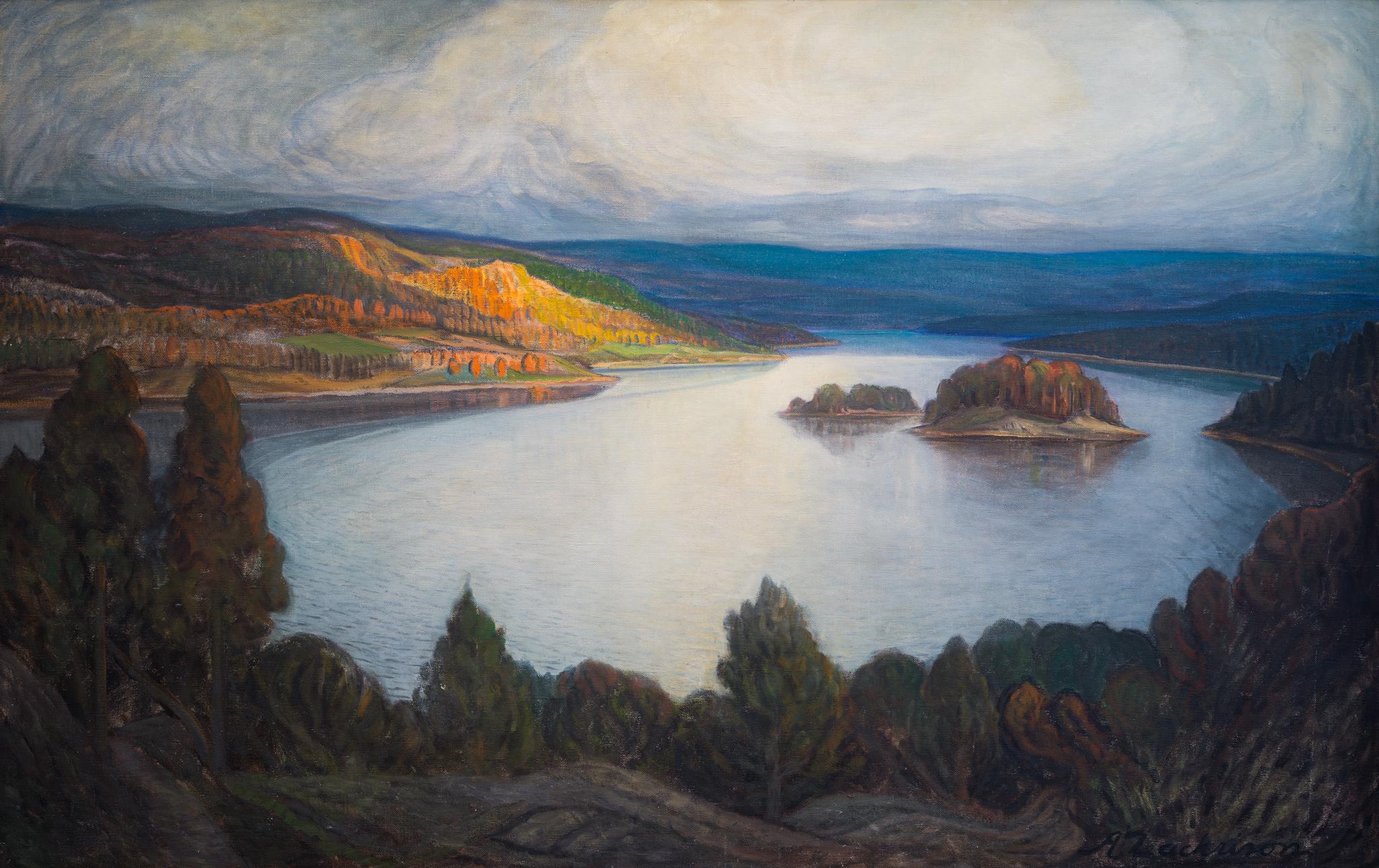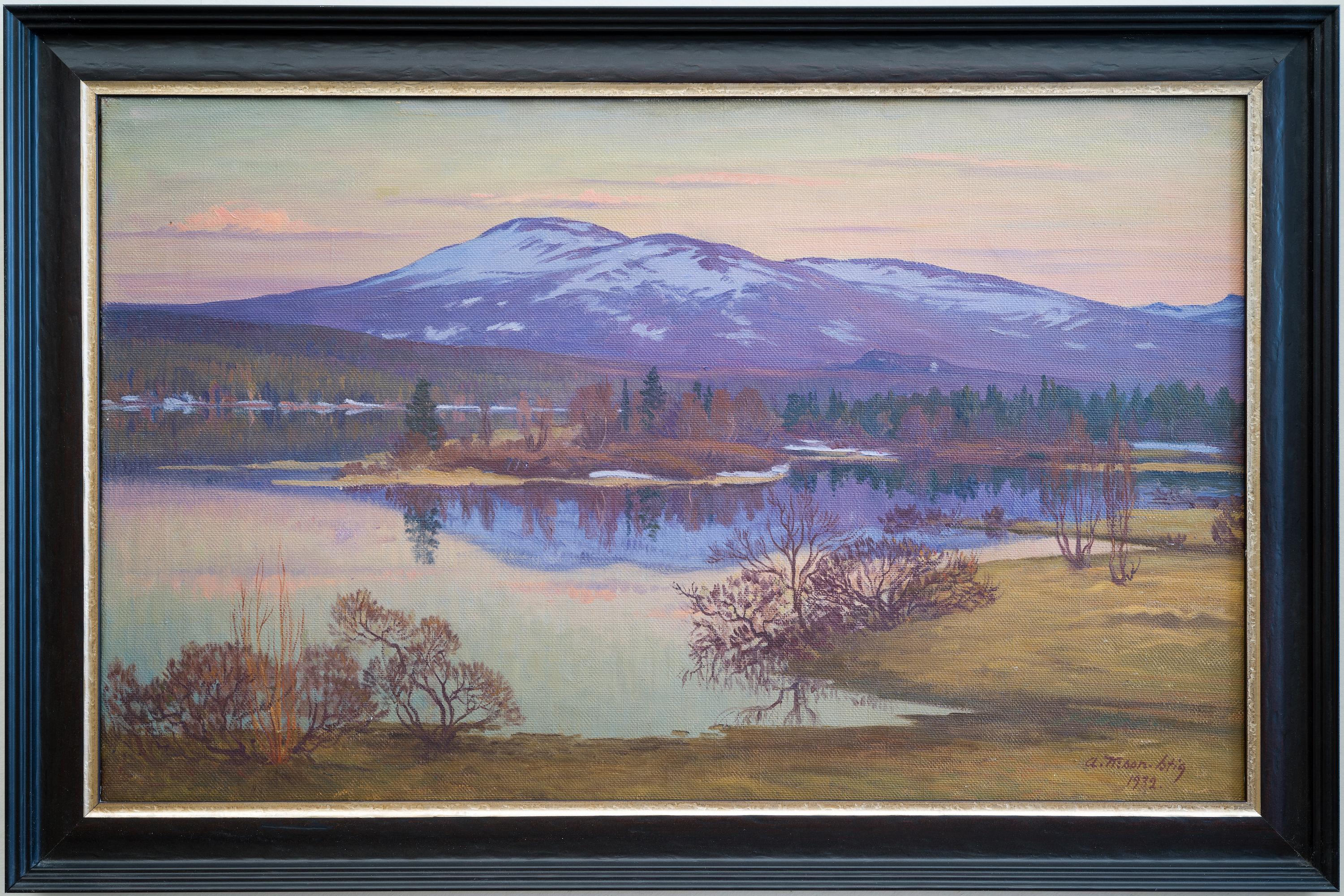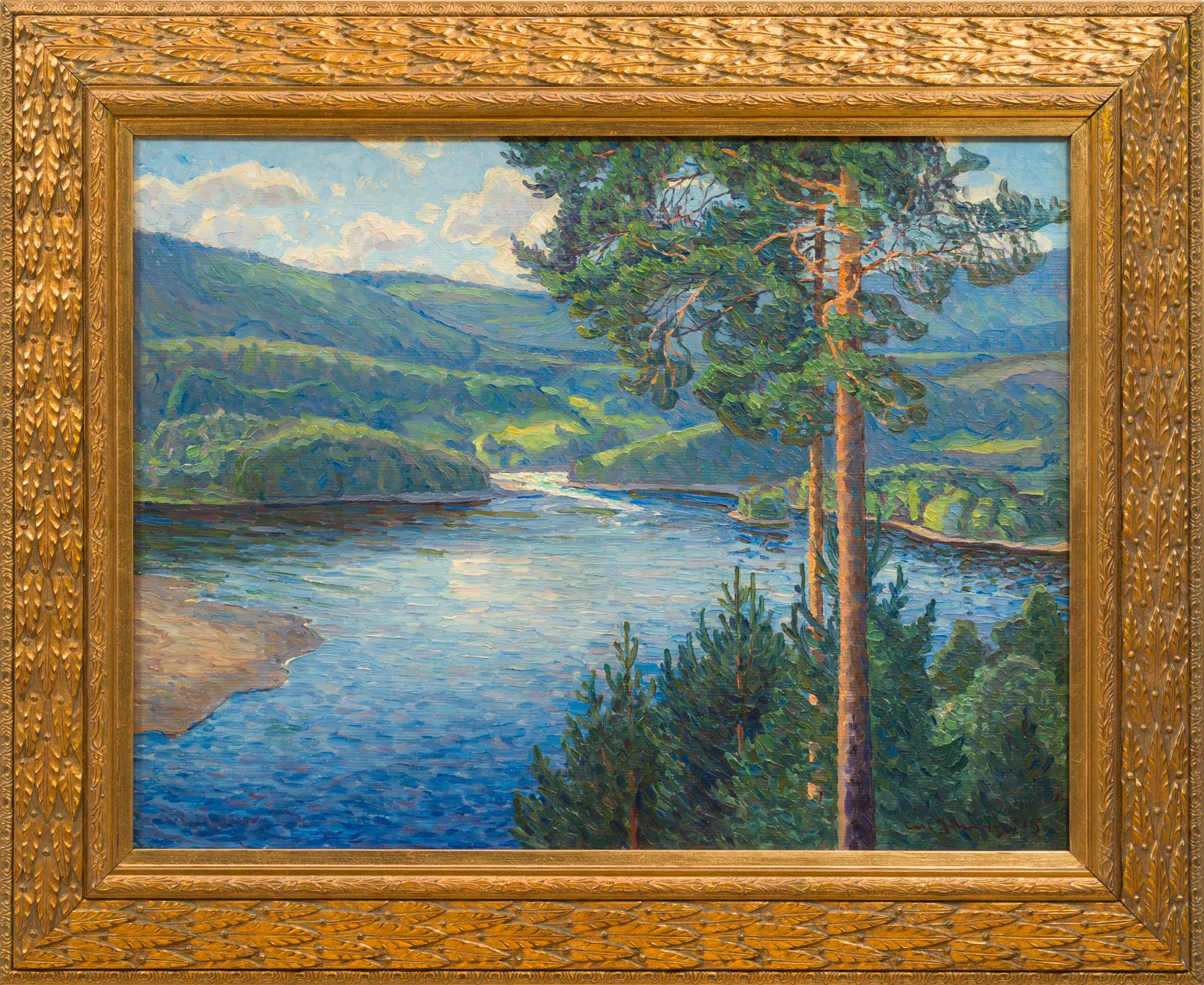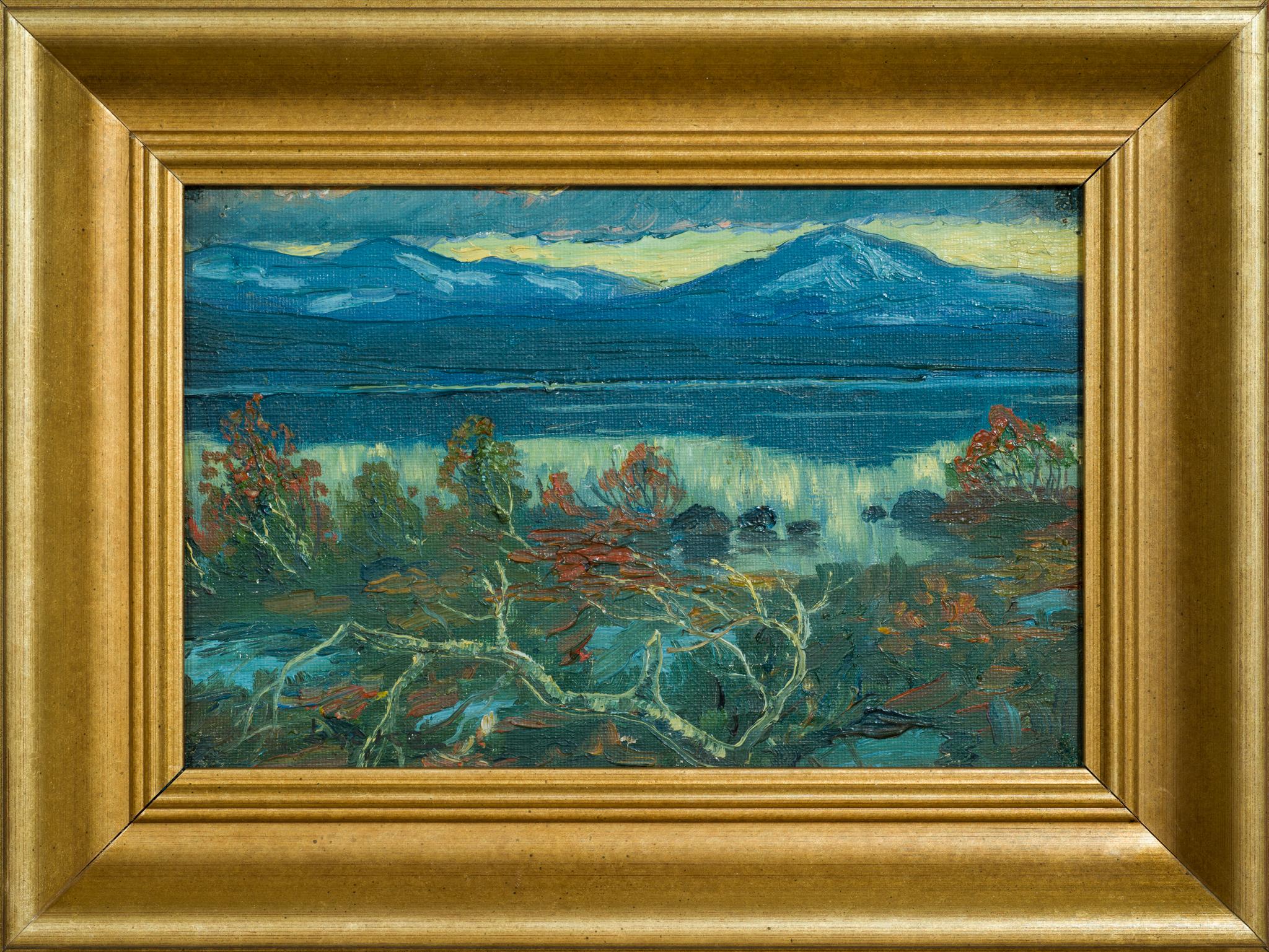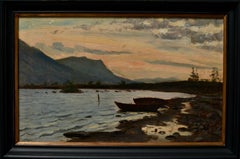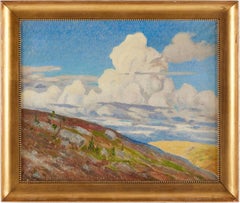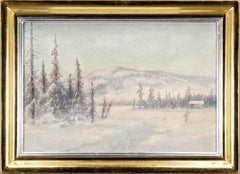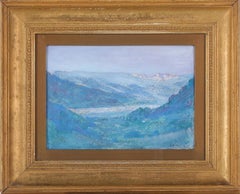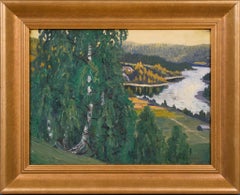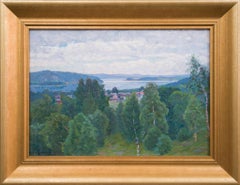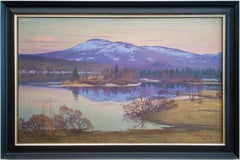Items Similar to Mountain Landscape, Northern Sweden, Oil on Panel.
Want more images or videos?
Request additional images or videos from the seller
1 of 9
Hilding NymanMountain Landscape, Northern Sweden, Oil on Panel.Early 1900´s
Early 1900´s
$518.59
$1,296.4860% Off
£390.60
£976.5160% Off
€440
€1,10060% Off
CA$715.16
CA$1,787.9160% Off
A$803.45
A$2,008.6360% Off
CHF 419.81
CHF 1,049.5160% Off
MX$9,806.53
MX$24,516.3360% Off
NOK 5,330.31
NOK 13,325.7760% Off
SEK 5,017.36
SEK 12,543.4160% Off
DKK 3,349.11
DKK 8,372.7860% Off
About the Item
A mountainous landscape painted by Hilding Elof Nyman (1870 - 1937). Oil on panel. The motif is probably from Dalarna in Swedens north part were he spent periods of his life. Nyman was a Swedish painter, draftsman and graphic artist.
Hilding Nyman studied, among other things, with the American artist W. L. M. Pendleton in Örebro between 1892 and 1893. Pendleton ran an art school in Örebro during the 1890s. Later, Nyman moved to Stockholm and became a student of Richard Bergh between 1898-1899 and then he studied at the Artists' Association's painting school in 1900. In 1901, Nyman went on several study trips that took him to Germany, the Netherlands and Belgium. During a short stay in Mora in 1911, he was also a student of Anders Zorn.
As a painter, Nyman's output was limited and mainly includes landscape pictures and depictions of folk life from Dalarna and Uppland. Nyman became better known as a cartoonist, where he worked for Strix (1897), Dagens Nyheter (1901), Svenska Dagbladet (1905) and Stockholms-Tidningen (1913-15). His cheeky, powerful illustrations in ink are very reminiscent of Albert Engström's style. Nyman was also active as a book illustrator.
Nyman participated in a number of exhibitions; Among other things, he exhibited at the Artists' Union's exhibition in Sthlm 1902, the Baltic exhibition in Malmö 1914, Erste internationale Kunstausstellung in Leipzig, the Swedish art exhibition at Charlottenborg in Köbenhavn 1916, Swedish graphics 1912–1919 at the Art Academy in 1919, Swedish art at Valand-Chalmers in Gbg 1923 and Contemporary English and Swedish graphics at the Art Academy in 1927. For N's development as a graphic artist, the studies for the skilled technician A Tallberg and even more so for Anders Zorn have been of great importance. As with Zorn, portraits dominate along with folk life motifs, scenes from lake shores, shacks and peasant life, executed in an elegant and evocative impressionism.
His works are represented in the National Museum, the Zorn Museum in Mora, Uppsala University Library as well as the Gothenburg Art Museum and the Östersund Museum.
- Creator:Hilding Nyman (1870 - 1937, Swedish)
- Creation Year:Early 1900´s
- Dimensions:Height: 13.39 in (34 cm)Width: 16.15 in (41 cm)Depth: 1.58 in (4 cm)
- Medium:
- Movement & Style:
- Period:
- Framing:Frame IncludedFraming Options Available
- Condition:The condition is very good.
- Gallery Location:Stockholm, SE
- Reference Number:1stDibs: LU2608214209772
About the Seller
5.0
Gold Seller
Premium sellers maintaining a 4.3+ rating and 24-hour response times
1stDibs seller since 2023
20 sales on 1stDibs
Typical response time: <1 hour
- ShippingRetrieving quote...Shipping from: Stockholm, Sweden
- Return Policy
Authenticity Guarantee
In the unlikely event there’s an issue with an item’s authenticity, contact us within 1 year for a full refund. DetailsMoney-Back Guarantee
If your item is not as described, is damaged in transit, or does not arrive, contact us within 7 days for a full refund. Details24-Hour Cancellation
You have a 24-hour grace period in which to reconsider your purchase, with no questions asked.Vetted Professional Sellers
Our world-class sellers must adhere to strict standards for service and quality, maintaining the integrity of our listings.Price-Match Guarantee
If you find that a seller listed the same item for a lower price elsewhere, we’ll match it.Trusted Global Delivery
Our best-in-class carrier network provides specialized shipping options worldwide, including custom delivery.More From This Seller
View AllSwedish Sunset over Lake and Mountains
Located in Stockholm, SE
Oil study by a lake and mountains during sunset by Edward Rosenberg (1858-1934). This is a an oil study for a larger painting that Rosenberg did. A te...
Category
Early 20th Century Naturalistic Landscape Paintings
Materials
Canvas, Oil, Cardboard
After the Storm
Located in Stockholm, SE
"After the Storm" is the title of this oil painting on canvas by the Swedish artist Hjalmar Berghcrantz (1889–1961). Signed and dated 1917. The artwork depicts a rugged landscape whe...
Category
1910s Naturalistic Landscape Paintings
Materials
Canvas, Oil
Mountain Winter Landscape
By Anselm Schultzberg
Located in Stockholm, SE
A quiet mountain winter landscape called "Winter road" or as it is written on the back in Swedish "Vinterväg" and “Vinterlandskap from Granberget at Rämen, Värmland", Gran-mountain ...
Category
Early 19th Century Other Art Style Landscape Paintings
Materials
Canvas, Oil
Mountain and Lake View, Gruyères
Located in Stockholm, SE
A watercolor depicting a mountain view and the lake Gruyère, (Lac De La Gruyère) in Switzerland by the American Impressionist and Tonalist Mary Rogers Williams (1857–1907). Signed M.R. Williams. On the verso, the artist wrote: ‘Painted in Gruyère July 1902.’ This is a newly discovered work by a rare woman artist who seldom appears on the art market. Small in scale, yet rich in atmosphere, power, and depth—a genuine little gem.
Mary Rogers Williams was born in 1857, in Hartford, Connecticut, the fifth of six children to a local baker. Orphaned by the age of fourteen, she pursued art with remarkable determination, studying at Hartford’s Decorative Art Society and the Art Students League in New York under William Merritt Chase. Her early mentor was James Wells Champney.
In 1888, she joined Smith College as associate professor of art, where she taught for nearly twenty years to help support her family. Alongside her academic career, she maintained a serious and evolving artistic practice, though much of it was pursued within the limitations of her era’s gender roles and financial pressures.
Her work is often classified as a blend of Tonalism and Impressionism—movements that were just taking shape during her lifetime. Tonalists used subdued palettes to evoke mood rather than detail, while Impressionists leaned toward brighter colors and broader subjects. Williams, working independently of art-world factions, forged a style rooted in mood, light, and atmosphere. She painted luminous pastels, watercolors, and oils—portraits, landscapes, and intimate studies of daily life.
Despite knowing figures like Whistler, William Merritt Chase, and Childe Hassam, she rarely aligned herself with any artistic “school” and found many male contemporaries pretentious or repetitive. She famously dropped out of Whistler’s Paris school, calling him “a pompous fop surrounded by fawners.” Though Mary Cassatt and Williams were both American Impressionists living in Paris, they never met—Cassatt enjoyed wealth and elite circles, while Williams was a self-reliant educator without patrons.
Williams traveled extensively throughout Europe—from the Arctic Circle to the ruins south of Naples—often alone or with her sister. She bicycled through fjords, hiked to medieval towns, and visited chateaux and harbors, all while sketching prolifically. She is likely the only 19th-century woman artist whose travels and daily life can be traced in such vivid, personal detail: what she ate, how she felt about fellow travelers, what she paid for trams, how the air smelled, what she wore, and how she missed home.
She documented everything—museum visits, church restorations, conversations with hotel guests, and her frustrations with men’s treatment of women artists. These letters, rediscovered in 2012 in a family boathouse, provide an extraordinary insight into not only her art but the intellectual and emotional texture of her life.
Her writings reveal not only artistic insight but the immense workload she carried. At Smith, she taught studio art and art history, organized faculty events, curated student exhibitions, wrote essays, handled housework, and even cooked and cleaned for her own lodgings. On vacations, she cooked for her family; in Europe, she waxed floors, painted walls, repaired clothing, and stoked fires—all while maintaining her painting and travel schedule.
Unlike many of her male peers, she had no assistants, no household staff, and little inherited wealth. Yet, as her letters reveal, she never saw herself as a victim—she relished challenges and even the absurdities of her era, from Italian waiters pushing marriage to department heads at Smith dismissing women’s artistic capacity.
Despite these challenges, Williams exhibited widely during her lifetime:
Paris Salon (1899)
National Academy of Design (1903–04)
Pennsylvania Academy of the Fine Arts
New York Water Color Club, American Water Color Society, Art Association of Indianapolis, and more.
She was praised in The New York Times, Hartford Courant, and Springfield Republican, and compared by peers to figures like Emily Dickinson—another New England woman of quiet yet profound artistic power. But unlike Dickinson, Mary Williams...
Category
Early 1900s American Impressionist Landscape Drawings and Watercolors
Materials
Paper, Watercolor, Cardboard
Stockholm View From The Royal Park Djurgården
Located in Stockholm, SE
A view of Stockholm painted from the Royal Park of Djurgården and overlooking the small island of Kastellholmen painted by Alfred Bergström (1869-1930)
The church visible in the background is Katharina church, built in 1695, located in Södermalm, Stockholm.
Signed: Alfr. Bergström, 1887.
Oil on canvas.
A very early work by Bergström when he was only 18 years old. Painted en plein air, probably during the late autumn or early winter of 1887 when he did his first year of study at the Royal Art Academy.
Alfred Maurits Bergström was a Swedish artist and professor at the Royal Academy of Arts. He was a painter, watercolorist and etcher.
During the years 1887–1891 he studied at the Academy and won the Royal Medal...
Category
1880s Naturalistic Landscape Paintings
Materials
Canvas, Oil
$1,555 Sale Price
40% Off
Hållö Lighthouse, Smögen at Sunset.
Located in Stockholm, SE
Serene sunset over the waters near Smögen on Sweden's west coast, with the sun setting just behind the island of Hållö and its lighthouse by female artist Ingeborg Westfelt-Eggertz. ...
Category
1890s Impressionist Landscape Paintings
Materials
Canvas, Oil
You May Also Like
Northern Valley View – Light, Stillness and Depth in the Swedish North
Located in Stockholm, SE
In this luminous landscape, Oscar Lycke invites us to experience the serene vastness of Sweden’s northern interior. Likely painted in the region surrounding Liden along the Indalsälv...
Category
1910s Impressionist Landscape Paintings
Materials
Oil, Board, Canvas
Original Oil Paining, A Landscape View, 1927, Most likely from Nordingrå, Sweden
Located in Stockholm, SE
Carl Johansson's painting from 1927, most likely depicting a view from Nordingrå, encapsulates the serene beauty of the northern Swedish landscape. Born in Härnösand, Johansson drew ...
Category
1920s Post-Impressionist Landscape Paintings
Materials
Oil, Wood Panel
Landscape Painting from Dalsland, Sweden by Axel Zachrison
Located in Stockholm, SE
Axel Zachrison was a Swedish painter known for his landscapes from Dalsland. Born in Tydje, Dalsland, Zachrison's artistic journey was shaped by his experiences at sea and his encounters with influential artists such as Otto Hesselbom, a relative on his mother's side.
This captivating landscape painting titled "Landscape from Dalsland, Sweden" showcases Zachrison's artistic talent and his ability to capture the beauty of nature. The sky, painted in shades of white and gray, features distinct lines around the clouds add a sense of movement and depth to the scene, reminiscent of Hesselbom's painting technique. In the background, we can see some blue mountains, their majestic presence contributing to the overall sense of grandeur.
And In the left part, the viewer can see some land illuminated by the warm rays of the afternoon sun. The vibrant colors of orange, green, and yellow bring the landscape to life, infusing it with a sense of vitality and serenity. A shimmering body of water in the the center, reflecting the luminous white light and creating captivating mirror-like reflections.
The foreground of the painting consists of a darker forest area which skillfully framing the lower part of the composition. This deliberate contrast adds depth and visual interest to the artwork, drawing the viewer's attention to the enchanting scenery.
It's undated but likely executed in the 1920s, the painting carries an undeniable "wow" factor upon first sight. Zachrison's skillful brushwork and his masterful use of decorative color choices create a captivating and immersive experience for the viewer. His ability to evoke emotional responses through his art is a testament to his talent and artistic vision.
Zachrison studied under the guidance of renowned artist Carl Wilhelmson...
Category
1920s Post-Impressionist Landscape Paintings
Materials
Canvas, Oil
Mountain View from Hålland, Åre by Swedish Artist Ante Karlsson-Stig, From 1932
Located in Stockholm, SE
The painting we are selling is a breathtaking mountain view from Hålland in Jämtland, Sweden, created by Ante Karlsson-Stig in 1932. Ante Karlsson-Stig (1885-1967) was a Swedish pain...
Category
1930s Naturalistic Landscape Paintings
Materials
Canvas, Oil
Vangforsen, Ramsele – Northern Light on the Faxälven River, 1915
Located in Stockholm, SE
Carl Johansson (1863-1944) Sweden
Vangforsen, Ramsele, 1915
oil on canvas
signed and dated Carl Johansson 15
unframed: 50 x 65.5 cm (19 5/8 x 25 3/4 in)
framed: 68 x 83 cm (26 3/4 ...
Category
1910s Impressionist Landscape Paintings
Materials
Canvas, Oil
Mountain Landscape with Lake
Located in Stockholm, SE
Swedish Mountain Landscape with Lake
oil on canvas laid on masonite
18 x 27 cm (7 1/8 x 10 5/8 in)
28 x 37 cm (11 x 14 5/8 in)
Provenance:
Acquired...
Category
1910s Post-Impressionist Landscape Paintings
Materials
Canvas, Oil, Board
More Ways To Browse
Swedish Panels
Swedish Impressionist
Swedish Impressionist Paintings
Early 1900s American Paintings
Swedish Oil Portrait
1911 Antiques
Netherlands Painting Early 20th Century
Dalarna Sweden
Mora Antiques
Australian Landscape Original Paintings
Mexican Horse
Vineyard Landscape Painting
Paintings Of Surrey Landscape
British Cars
D J David
Impressionist Sailboat Paintings
Nantucket Painting
Watercolor Winter Scenes
